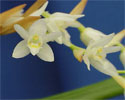|
|
|
|
|
| |
Flasks of
Coelogyne flexuosa 'MC3554' × self |
|
| |
|
|
| |
|
|
Click to Enlarge

Pod Parent Flowers |
|
|
|
| |
Culture Notes from Donor: Parent plant: Temperature range I (60-83°F)
For additional origin/habitat information supplied courtesy of
Charles and Margaret Baker, see further below, near the bottom of this page.
|
Temperatures we attempt to use in the lab & greenhouse:
| For Species: |
|
Spring, Summer, Autumn, Winter: days average 72°F, nights 57°F; best fit is Cool-Intermediate 75-58°F
(Source:
Baker's Web OSC) |
|
About the name...
| Etymology of |
Coelogyne |
|
From latinized Greek "koilos" hollow, cavity; "gyne" woman, womb, stigma. The column is frontally hollow.
(Source:
Mayr & Schmucker 1998) |
| Etymology of |
flexuosa |
|
From Latin "flexuosus" bent (flower raceme).
(Source:
Mayr & Schmucker 1998) |
| Pronunciation of |
Coelogyne |
|
see-LAW-ji-nee
(Source:
Hawkes 1978) |
| Pronunciation of |
flexuosa |
|
flex-yoo-OH-sa
(Source:
Hawkes 1978) |
|
If you would like to direct someone to this web page, please copy and paste this URL into your email:
http://troymeyers.com/d?015416
| Flask Information |
| Availability: |
We have sold all of the flasks for this item. |
| You should: |
Consider getting individual plants or compots instead of a flask.
You can place a "Notify Flask Recipients" Request, and either we or a flask recipient may contact you when plants are available.
You may also place a "Notify Retries" Request, and if an identical pollination (the same parents) is done again, we'll let you know.
You may reserve a flask, but it's very unlikely you'll get one ...this could only happen if we found a flask that we didn't know we had. |
| Yield Estimate: |
270 plants (based on flask surveys done 06/01/2006 through 01/17/2007)
|
| Plantlet Sizes: |
From many flasks 20 - 35 mm plants (based on flask surveys done 01/29/2007 through 07/10/2007)
From one most recently surveyed flask 20 - 30 mm (07/10/2007)
|
|
You might also want to:
|
View the seed assay for this item.
View items of the same species.
View items of the same genus.
|
| Ordering Information |
| You are not currently logged in. |
|
You must be a registered user and be logged in to reserve a flask or place a notification request. Please log in:
|
|
|
|
|
|
| |
The origin/habitat information below is supplied courtesy of Charles and Margaret Baker
The following information is based on the name of the plant provided by the donor, and assumes that the name is correct. If the plant has been misidentified, then the following information may not be correct.
This text is copyrighted by the Bakers and may not be reproduced without permission.
ORIGIN/HABITAT: Java. The plant is rather common in east Java where its
distribution is confined to the seasonal conditions found on the drier
northern slopes of the mountains, particularly Mt. Tengger and Mt. Arjuno,
at 2950-5000 ft. (900-1520 m). They generally are found high up on
isolated tree trunks and branches where light levels are high. Although
reported as occurring in both Sumatra and Malaya, Seidenfaden & Wood
(1992) reported that the description of the Malayan plant was based on a
cultivated plant in Singapore that supposedly had originated in the
Taiping Hills, but later collections have not been made. Comber (2001)
reported that the Sumatran record was of a cultivated plant reportedly
collected in West Sumatra, but that he had not seen a collection from the
wild. He stated that the reports of occurrence in both Malaya and Sumatra
are in doubt because the species in Java is confined to a region with a
seasonal climate while the climate in both Sumatra and Malaya is
relatively without season.
More about this information and the Bakers...
|
|
|
| |
|
|
|